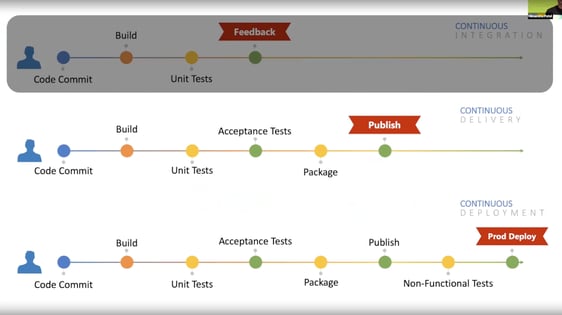Himanshu Patel discusses the benefits of a well-functioning DevOps team.
Many can probably relate to a situation at your current job where you are just too busy to take care of inefficiencies, improve quality, or boost productivity. As a result, you develop technical debt and technical silos at our workplace. For instance, manual processes may be choking the team and keeping it from improving or progressing at all. If this isn't already bad enough, let's take a look at the impact on the company:
- Slow time to market
- High costs and high risks
- High maintenance overhead
- Poor code quality
If these drawbacks sound familiar, it's time to reflect on your current situation and make an improvement plan. Many organizations underestimate the impact of evolving or innovating their DevOps team. Therefore, this post focuses on evolving your DevOps setup and discusses which technologies are available to achieve this.
1. The Road to Continuous Deployment
Most companies are familiar with continuous integration (CI) by now. The idea of continuous integration is to build a fast feedback loop for developers. They commit code and the continuous integration pipeline builds the application, runs unit tests or other types of tests, and returns code feedback. In a matter of minutes or even seconds, developers know if their code works.
In addition, innovations in the DevOps industry made continuous delivery (CD) possible. Developers would build their code, run unit tests, run acceptance tests, package the application, and publish it, and that's where CD ends. Other applications or release managers can pick up the deployable application and deploy it to a particular environment for further testing. Yet this is not done automatically.
And lastly, continuous deployment goes even beyond creating a deployable application. It executes the same steps as continuous delivery but also automates the deployment of applications to different environments. Therefore, the continuous deployment approach spins up new environments dynamically, deploys the application, and runs tests against the application. For instance, smoke testing is a form of acceptance testing that verifies if the most important code paths or functions work as expected. If all tests succeed, the application will be deployed to the production environment. All of this happens automatically, without human interaction.
It's clear that you can reduce lead time for your organization by implementing continuous deployment. However, even implementing just CI or configuring CD will benefit your developers and your company. The goal is to deliver value to customers faster and detect defects quicker. CI, CD, and continuous deployment will each save your organization time and money.
 An overview of continuous integration vs continuous delivery vs continuous deployment from Himanshu Patel’s “Evolving DevOps in the Age of Kubernetes!” presentation
An overview of continuous integration vs continuous delivery vs continuous deployment from Himanshu Patel’s “Evolving DevOps in the Age of Kubernetes!” presentation
So, what else can you do?
2. Adopting Microservices Architecture
Many organizations still use monolithic applications, which increase testing complexity but also increase deployment complexity. To enjoy the benefits of containerization and cloud services, your team should consider adopting a microservices architecture.
A microservices architecture allows your team to containerize each service and scale individual services based on demand. For instance, if there's a lot of demand for your product service, you don't have to scale your entire application but only the service that experiences high demand. Again, this will save your organization time and money.
On top of that, the continuous deployment approach explained earlier works well with microservices. Continuous deployment can easily package services and deploy them automatically to the correct environment for testing. A monolithic application requires a complex setup and a lot of time to get right. By breaking up your application into multiple services, you can speed up the feedback loop for developers. For example, you can have multiple continuous deployment pipelines in parallel and reduce the time needed to configure an environment for testing your application. In short, microservices require much less setup than a monolithic application.
3. Controlled Deployments
Lastly, let's explore how controlled deployments can help your organization manage risks. A controlled deployment rolls out software updates to only a small portion of your user base. This strategy allows you to verify if the application update works as expected before rolling it out to your entire user base.
In case something goes wrong, you can quickly roll back to the previous version while minimizing the impact of the problem on your user base. It's a great way to reduce the risk of problematic deployments. On top of that, you can guarantee a higher degree of service availability, which creates happier customers.
Conclusion
Innovation is essential not only in developing applications, but also for your DevOps team. Many organizations underestimate the impact DevOps teams have on the value a business delivers. A well-functioning DevOps team can speed up your time to market, improve product value, and reduce costs. Don't overlook these benefits because your team is too busy.
If you want to get started, dedicate a few hours per week to improving processes or exploring new technologies to see how they work for your team. In other words, include continuous improvement in your weekly routine.



.png?width=610&name=J1_ModernCybersecurityBook_Promo%201200x628%20v2@2x%20(1).png)



